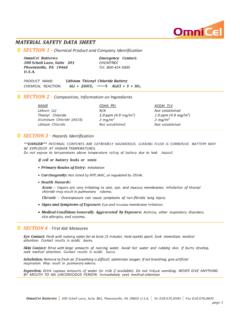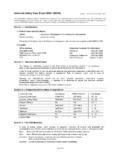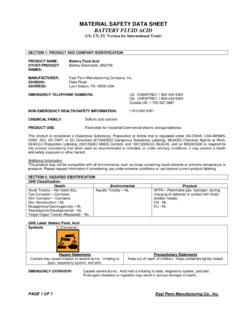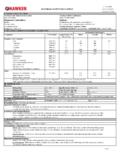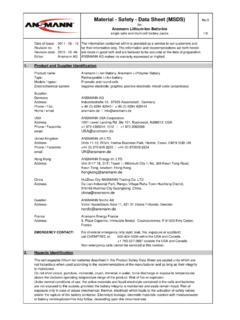Transcription of MATERIAL SAFETY DATA SHEET - Industrial Battery …
1 MATERIAL SAFETY data SHEETnSECTION 1 - Chemical Product and Company IdentificationOmniCel BatteriesEmergency Contact:300 Schell Lane, Suite 301 CHEMTRECP hoenixville, PA 19460 Tel: NAME: Lithium Manganese Dioxide (Li-MnO2) BatterynSECTION 2 -Hazardous InformationHazardous Components:Description:1. Lithium2. Manganese DioxidenSECTION 3 -Physical / Chemical CharacteristicsBoiling Point:N/AVapor Pressure (mm Hg):N/AVapor Density (AIR=1):N/ASolubility in Water:N/AAppearance and Odor:Cylindrical Shape, OdorlessSpecific Gravity (H2O=1):N/AMelting Point:N/AEvaporation Rate (Butyl Acetate): N/AnSECTION 4 -Hazard ClassificationClassification: N/AUN Test: TestProduct / MATERIAL : Lithium Manganese Dioxide cellTrademark: OmniCelRated specification: compliance with: 1: Altitude SimulationTest 5: External Short CircuitTest 2: Thermal Test 6: ImpactTest 3: VibrationTest 7: Forced DischargeTest 4: ShockTest 8: OverchargeOmniCel Batteries300 Schell Lane, Suite 301, Phoenixville, PA 19460 Tel Fax page 1nSECTION 5 -Reactivity DataStability: Stable StatusConditions to Avoid:FireIncompatibility (Materials to Avoid): AcidsHazardous Decomposition or Products: N/AHazardous Polymerization: Will not occurnSECTION 6 -Health Hazard DataRoutes of Entry: Inhalation.
2 N/A Skin: N/A Ingestion: N/A Health Hazard (Acute and Chronic) / Toxiclogical information:In case of electrolyte leakage, skin will be itchy when contaminated with electrolytes. Contact with electrolytes can cause severe irritation and chemical burns. Inhalation of electrolyte vapors may cause irritation of the upper respiratory tract and 7 -First Aid Measures If electrolyte leakage occurs and makes contact with skin, wash with plenty of water immediately. If electrolytes come into contact with eyes, wash with copious amounts of water for fifteen (15) minutes, and contact a physician. If electrolyte vapors are inhaled, provide fresh air and seek medical attention if respiratory irritation develops. Ventilate the contaminated 8 -Fire and Explosion Hazard DataFlash Point (Method Used): N/AIgnition Temperature: N/AFlammable Limits: N/ALEL: N/AUEL: N/AExtinguishing Media: Carbon dioxide, dry chemical or foam extinguishersSpecial Fire Fighting Procedures: N/AUnusual Fire and Explosion Hazards: Do not dispose of Battery in fire may explode.
3 Do not short circuit Battery may cause 2 OmniCel Batteries300 Schell Lane, Suite 301, Phoenixville, PA 19460 Tel Fax nSECTION 9 -Accidental Release or SpillageSteps to be taken in case MATERIAL is released or spilled: Batteries that are leaking should be handled with rubber gloves. Avoid direct contact with electrolytes. Wear protective clothing and a positive pressure Self Contained Breathing Apparatus (SCBA).nSECTION 10 -Handling and StorageSafe handling and storage advice: Batteries should be handled and stored carefully to avoid short circuits. Do not store in disorderly fashion, or allow metal objects to be mixed with stored batteries. Never disassemble a Battery . Do not breathe cell vapors or touch internal materials with bare hands. Keep batteries between 15 C and 35 C for prolonged 11 -Exposure Controls / Personal Protection Respiratory Protection (Specify Type): N/AVentilation: N/ALocal Exhausts: N/ASpecial: N/AMechanical (General): N/ASpecial: N/AOther: N/AEye Protection: N/AProtective Gloves: N/AOther Protective Clothing or Equipment: N/AWork / Hygienic Practices:N/AnSECTION 12 -Ecological InformationN/AnSECTION 13 -Disposal ConsiderationsDispose of batteries according to government 3 OmniCel Batteries300 Schell Lane, Suite 301, Phoenixville, PA 19460 Tel Fax SECTION 14 -Transportation InformationLithium metal (primary) cells and batteries are classified and regulated as Class 9 dangerous goods (also known as hazardous materials in the United States) by the International Civil Aviation Organization (ICAO), International Air Transport Association (IATA), International Maritime Organization (IMO) and Department of Transportation (DOT).
4 These organizations and agencies publish regulations that contain detailed packaging, marking, labeling, documentation,and training requirements that must be followed when offering (shipping) cells and batteries for transportation. The regulations are based on the UN Recommendations on the Transport of Dangerous Goods Model Regulations and the UN Manual of Tests and Criteria. The regulations also have specific training requirements for employees whoprepare lithium batteries or lithium batteries packed with or contained in equipment. Failure to comply with these regulations can result in substantial civil or criminal penalties.* Small cells and batteries may not be subject to certain provisions of the regulations ( , Class 9 labeling and UNspecification packaging) if they meet specific requirements. (See regulations referenced below for more information.)Cell and Battery UN Testing Requirements: The hazardous materials regulations require that each cell and batterydesign be subject to tests contained in Section of the UN Manual of Tests and Criteria.
5 Batteries or batterypacks constructed from UN tested cells must be subjected to tests contained in the UN Manual of Testsand : US DOT -49 CFR , See also 49 CFR Special Provisions 29, 188, 189, 190 , A54 andA55, A100, A101, A103, and A104 IATA/ICAO -Packing Instructions 903, 912, and 918; Special Provisions A45, A88, and A99, A154, A164 IMDG Code -Packing Instruction 903, Special Provisions 188, 230, 310, and 957 CLASS 9 LABEL*PROPER SHIPPING NAMES:UN NUMBERS:0903 NUseirettab muihtiLLithium batteries containedUN3091in equipment*When required1903 NUdekcap seirettab muihtiLwith equipmentSECTION 15 -Regulatory InformationSpecial requirements according to the local 16 -Other InformationThe data in this MATERIAL SAFETY data SHEET relates only to specific MATERIAL designated 17 -Fir e Fighting MeasuresExtinguishing Media: In case of fir e, it is permissible to use any class of extinguishing medium on these batteries or their packing MATERIAL .
6 Cool exterior of batteries if exposed to fir e to prevent e Fighting Procedures: Fir e fighters should wear Self Contained Breathing 4Li-MnO2 MSDS 04/14 OmniCel Batteries300 Schell Lane, Suite 301, Phoenixville, PA 19460 Tel Fax
